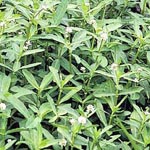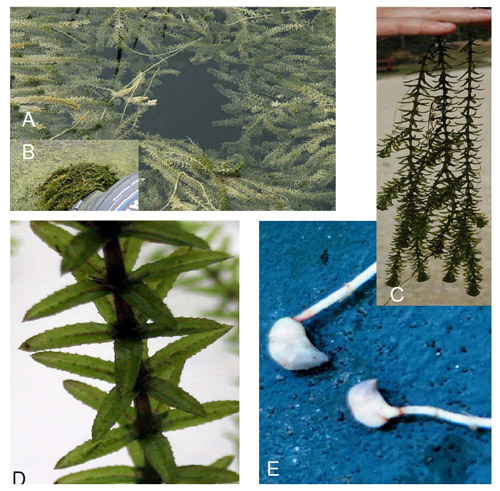Hydrilla
 Hydrilla verticillata
Hydrilla verticillata
Common Names: Hydrilla, Florida Elodea, Water Thyme, Indian Star-vine.
History: Hydrilla was introduced into the United States in the 1960s in Florida. It is native to parts of Asia, Africa, and Australia. It is thought to have been introduced through the aquarium trade.
Â
Physical Description
General: Hydrilla's appearance can vary considerably depending upon growing conditions. Hydrilla is a submersed, rooted aquatic plant that can grow from depths of 6m (20') or more.
Leaves: Leaves are whorled in bunches of 3-8. The midribs of the leaves are reddish in colour and the margins are slightly toothed. Leaves vary from green to brown and are finely toothed.
Flowers and Fruit: Tiny, translucent to white flowers produced on the upper branches in late summer and fall; tubers grow from the roots; winter buds (turions) are produced in the leaf axils.
Threat
Hydrilla crowds out native plants by shading them and outcompeting them for nutrients. Its dense masses interfere with recreational activities such as boating, fishing and swimming.
Distribution
Hydrilla is not found in Manitoba yet, but this invasive is expanding its range northward and along both coasts of the United States. Hydrilla can be dispersed by riverflow, waterfowl and recreational activities and is often sold as an aquarium plant. Report sightings to the ISCM.

[A] Infestation of Hydrilla [B] Hydrilla tangled on a boat motor. [C] View of a Hydrilla plant [D] Top of Hydrilla plant [E]Serrated leaves [F] Turions at the end of stems.
Photos: [A] David J. Moorhead, University of Georgia, Bugwood.org [B] Wilfredo Robles, Mississippi State University, Bugwood.org [C] Chris Evans, River to River CWMA, Bugwood.org [D] [E] J.H. Rodgers [F] USDA ARS Archive, Bugwood.org
Â
Back to Aquatic Invasive Species List
Â

